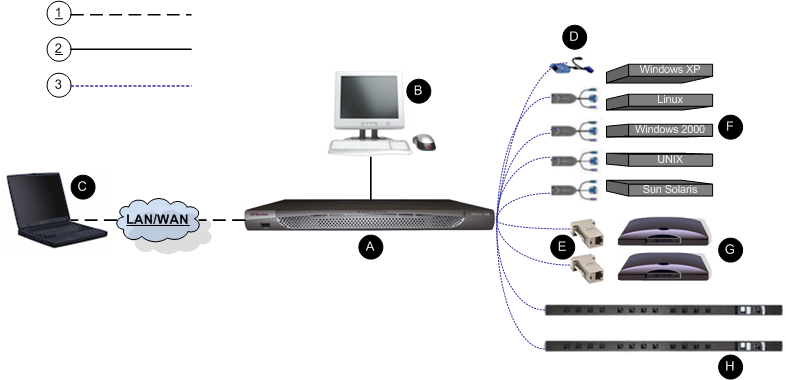This manual uses the following terminology for the components of a typical Dominion KSX configuration:

Diagram key |
|
|---|---|
|
TCP/IP |
|
KVM (Keyboard, Video, Mouse) |
|
UTP Cable (Cat5/5e/6) |
|
KSX II |
|
Local Access Console Local User - an optional user console (consisting of a keyboard, mouse, and multi-sync VGA monitor) attached directly to the Dominion KSX to control KVM target servers and serial targets locally (directly at the rack, not through the network). Local Administrator - use the Local Administrator port to connect the KSX II directly to a workstation to manage your serial targets and configure the system with a terminal emulation program such as HyperTerminal. The Local Administrator port requires the use of a standard null modem cable. |
|
Remote PC Networked computers used to access and control KVM target servers and serial targets connected to the Dominion KSX. Refer to Supported Operating Systems (Clients) for a list of the Operating Systems supported by the Dominion KSX remotely. |
|
CIMs Dongles that connect to each target server. Available for all of the supported Operating Systems. Refer to Supported CIMs for information about the CIMs supported by the Dominion KSX. |
|
Serial Adapter Adapters that connect serial cables. |
|
Target Servers KVM Target Servers - servers with video cards and user interfaces (for example,\, Windows®, Linux®, Solarisä, and so forth) connected remotely via the Dominion KSX. Refer to Supported Operating Systems and CIMs (Target Servers) for a list of the supported Operating Systems and CIMs. Serial Targets - Servers, routers, and switches that have a serial port connected remotely via KSX II. |
|
Routers |
|
Dominion PX Power Strip Raritan power strips accessed remotely via the Dominion KSX. |